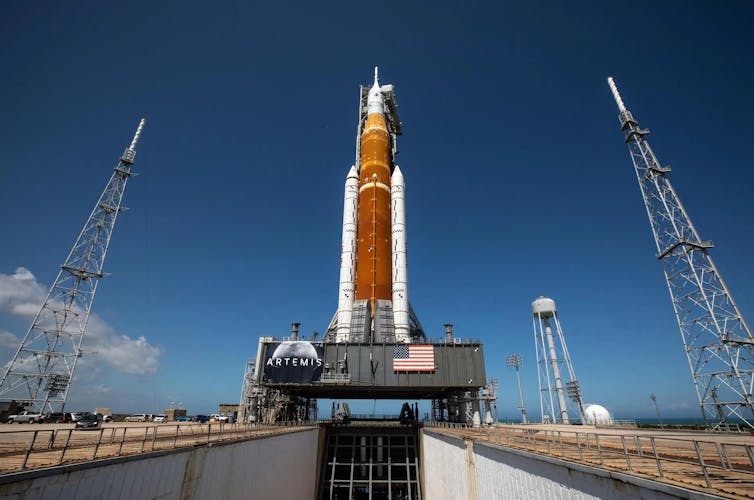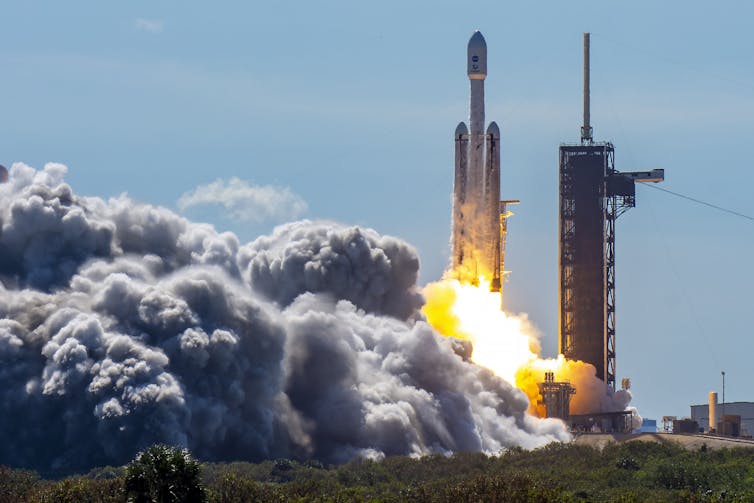Since Donald Trump’s recent election victory, rumors and speculation have spread that NASA’s giant moon rocket, the Space Launch System (SLS), may be in danger. The rocket is one of several key elements required for the US space agency’s Artemis program, which aims to return humans to the Moon for the first time since 1972.
For the first lunar landing mission, called Artemis III, SLS will launch four astronauts aboard NASA’s Orion crew capsule. After this Orion will travel to the Moon. Once in lunar orbit, Orion will dock with Elon Musk’s Starship vehicle (which is launched separately). Two astronauts will float in the Starship, which launches from Orion and heads to the moon’s surface.
After walking on the Moon, both astronauts return to lunar orbit in the Starship, which docks with Orion. Both moonwalkers reunite with their companions and fly home on Orion, leaving the starship in Moon orbit.
American space journalist Eric Berger recently posted on The Space Launch System rocket will be cancelled.”
No official announcement has been made. However, such a move could be in line with previous speculation that the Trump administration might dismantle NASA, forcing it to turn much of its work over to private companies.
But could any other rocket easily replace the SLS? This question goes deep into what America wants to achieve amid the emerging space race of the 21st century. China has promised to send its astronauts to the lunar surface by 2030. Unlike the US, China is generally conservative in its projections, so we can assume that missing the deadline is unlikely. Meanwhile, several elements of Artemis are thrown off schedule.
One of these delayed elements is Musk’s Starship, which serves as a lander on Artemis III. It still needs to perform major milestones, including refueling in space and landing on the moon without a crew. Some in the space community believe that if China reaches the Moon first this century, it would deal a major blow to American ambitions in space.
Musk has been brought in as one of two main cost cutters in the incoming administration, which aims to cut up to US$2 trillion (£1.57 trillion) from the federal budget. Some observers have become concerned with Elon Musk’s closeness to Trump and comments by the president-elect about a focus toward a crewed Mars mission.
These comments appear to reflect the views of Musk, who has focused most of his energy not on the Moon, but on ambitions to colonize the Red Planet. The billionaire has said he wants to send humans to Mars using his Starship vehicle by 2028 – a timeline that some consider unrealistic.

It was actually the first Trump administration that established the Artemis program in 2017. After initial missions to the lunar surface, the program aims to establish a permanent base where astronauts can learn to live and work on the Moon while conducting cutting-edge research. ,
However, the schedule is slipping. American astronauts were to land on the moon this year. NASA now says the first landing during the Artemis III mission will not occur until autumn 2026.
Delays have been caused by new spacesuit designs, problems with Orion’s heat-shield and life support systems, and, as mentioned, Starship. An advanced mobile launch tower for the SLS also suffered from cost overruns and schedule slippage.

In particular, one element that is not contributing to the delay is the SLS, which performed very well during the Artemis I mission in 2022. Several billion dollars have already been invested in the design and construction of SLS and related infrastructure at NASA’s Kennedy Space Center. Florida.
NASA says the SLS is “the only rocket that can send Orion, astronauts and cargo directly to the Moon in a single launch”. But its expense has been criticized: each SLS launch is estimated to cost more than US$2 billion (£1.6 billion).
News of delays and technical issues with Artemis coincides with Musk’s extremely positive PR for SpaceX – particularly around test flights of Starship. That includes last month’s accomplishment, where the vehicle’s giant booster stage was captured in a pair of robotic arms as it fell from space back to the company’s launchpad in Texas — which astonished space enthusiasts around the world. Had done.
Unlike many launch vehicles, Starship is designed to be completely reusable. Its cost efficiency could greatly benefit future crewed missions.
If SLS were cancelled, could Musk’s Starship replace it? Under this scenario, the SpaceX vehicle could potentially serve as a launcher to send astronauts to lunar orbit and a lander to take them to the surface. It’s technically possible, but it would be far from a straightforward, like-for-like replacement. The SLS is already an operational rocket, while Starship is still in its testing phase and there are still important steps to take before astronauts can board it.
Another SpaceX rocket that was previously seen as a contender to launch Orion is the Falcon Heavy. However, engineers will need to modify both the rocket and procedures for assembly and launch. There will be many uncertainties, and the risk of further significant delays to the Artemis schedule. All this suggests that there is not much time to make major changes to NASA’s Moon program if the United States is to get ahead in the 21st century space race.

Rocket launches require specific design to meet mission requirements, as well as extensive planning to carry the astronauts, spacecraft, and payload. Artemis is not only intended to land astronauts on the Moon, but also to be able to land in various areas on the Moon’s surface, including the relatively unknown South Pole.
The planning and development required is extremely complex and ambitious. It remains to be seen whether SpaceX, or any other commercial launch companies, are ready for such a huge undertaking and commitment.
With billions of dollars already invested in the SLS, eliminating the rocket entirely does not appear to be economically beneficial. As indicated by NASA’s desire to seek an innovative approach on future Artemis missions and to work with commercial companies, there may be other ways for commercial space players to get involved.
It makes sense for the incoming Trump administration to question NASA’s programs and cost models. But it would be advisable for them to think carefully before taking decisions that have such wide-ranging consequences.
This may depend on whether the priority is to win the new space race. Whatever target priority or goals the new administration chooses, it may have to carefully justify that decision to other legislators and the American public.![]()
Yang Gao, Professor of Robotics, Head of the Robotics Research Center, King’s College London
(This article is republished from The Conversation under a Creative Commons license. Read the original article.)
(Except for the headline, this story has not been edited by NDTV staff and is published from a syndicated feed.)





